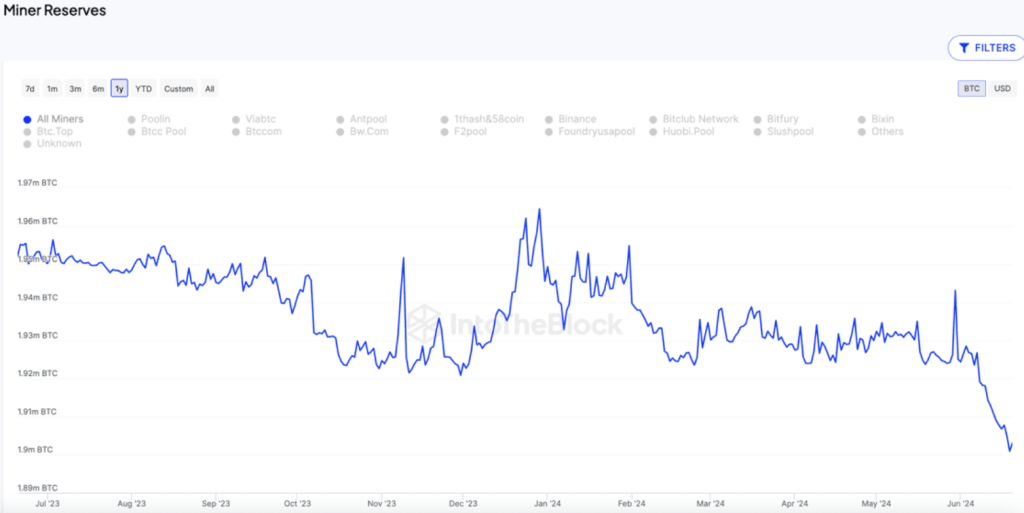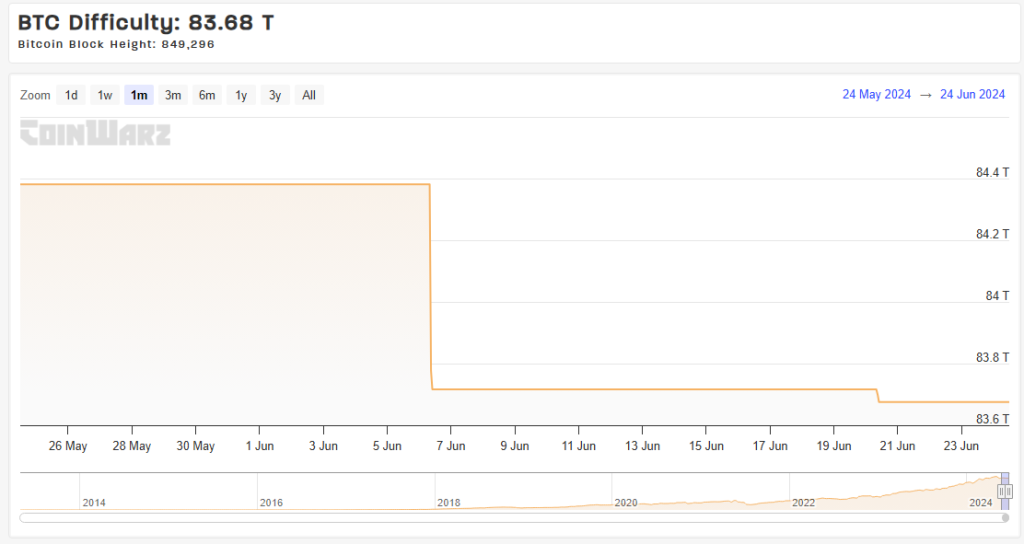The winds of change are roaring via the Bitcoin blockchain. The digital gold rush has hit a snag because the April 19 halving, a prearranged occasion that cuts miner rewards in half.
Miners are the lifeblood of the community, answerable for validating transactions and securing the blockchain, however they face a harsh actuality – their revenue has been minimize in half. This decline, mixed with record-low terahash-per-second (TH/s) income, triggered an exodus of miners, impacting Bitcoin’s value and community safety.
Hash Escape: Risk or Alternative?
The direct consequence is a large exodus of miners, particularly these with much less environment friendly mining machines. Information from IntoTheBlock reveals that since June alone, miners have bought greater than 30,000 BTC price almost $2 billion. The sell-off has undoubtedly contributed to the plunge in Bitcoin costs, that are at the moment round $61,140 after failing to interrupt above the $69,000 resistance zone over the previous two weeks.
🚨 Since June, Bitcoin miners have bought greater than 30,000 BTC (about $2 billion), which is the quickest tempo in additional than a yr. The latest halving triggered margins to tighten, triggering a sell-off. pic.twitter.com/dy289bu7p4
— IntoTheBlock (@intotheblock) June 22, 2024

Supply: IntoTheBlock
Nevertheless, the affect on cybersecurity stays a degree of debate. Some analysts consider the exodus is a crucial shake-up. The halving is a well known occasion. It forces networks to develop into extra environment friendly. Weaker miners might be eradicated, and so long as the remaining miners can stay worthwhile, the general safety of the community might be strengthened.

Supply: CoinWarz
This sentiment was echoed by trade giants like enterprise intelligence agency MicroStrategy, which lately doubled down on its bets on Bitcoin by buying a further 11,900 Bitcoins amid the worth decline. Michael Saylor, CEO of MicroStrategy, regards the halving as a long-term bullish sign. “Bitcoin’s primary worth proposition has not modified. Shortage remains to be king, and institutional adoption continues to rise.
Bitcoin: Balancing Effectivity and Sustainability
The exodus has raised issues in regards to the environmental affect of Bitcoin mining. Much less environment friendly drilling machines, usually powered by fossil fuels, are being phased out. Nevertheless, the remaining miners function bigger, extra environment friendly amenities that will require extra power to take care of the safety of the community. This may increasingly offset the environmental advantages of the outmigration.
The inflow of establishments: a blessing or a curse?
Actually, institutional funding has been Bitcoin’s brilliant spot. BlackRock, the world’s largest asset administration firm, has managed greater than $20 billion in Bitcoin property up to now month. The surge in institutional capital is a far cry from Bitcoin’s early days when retail buyers dominated the market.
The subsequent few weeks might be essential for Bitcoin. The potential approval of an Ethereum ETF may reignite investor curiosity and push the general cryptocurrency market ahead. Nevertheless, continued miner capitulation and outflows from Bitcoin ETFs may put additional downward strain on costs.
Featured Picture from Inspiring Managementchart from TradingView
